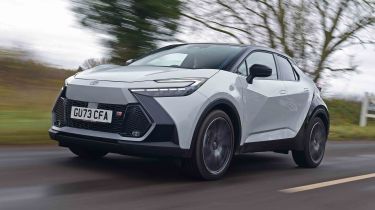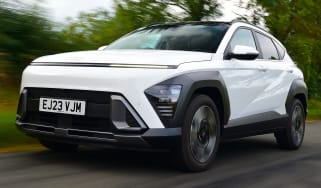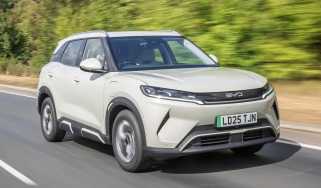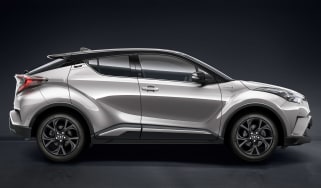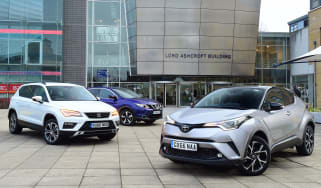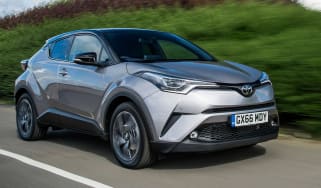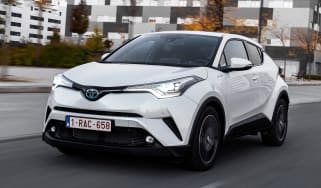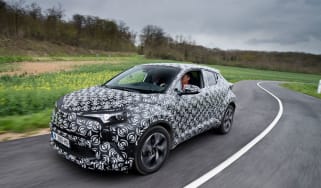Toyota C-HR review
The bold Toyota C-HR combines strong equipment levels, high efficiency, and lots of safety features, but it’ll cost you

Our opinion on the Toyota C-HR
The Toyota C-HR impresses with excellent real-world efficiency, a plush cabin, and an interior filled with tech that’s easy to use. It comes standard with many safety features, and its all-hybrid engine lineup means low emissions. Credit should be given to the designers for keeping the same bold styling that made the Mk1 such a hit, because this Mk2 version looks just as dramatic.
The 2.0-litre model we’ve driven offers plenty of performance for everyday driving, but it only comes in top GR Sport specification, which means it’s a costly option compared with rivals. The CH-R Plug-in Hybrid is also very expensive and is best suited to company car drivers to help keep their tax bills low. Overall, we think the well-equipped Design trim is the best value for money, even if you have to go for the less powerful 1.8 Hybrid model.
| Key specs | |
| Fuel type | Petrol/electric hybrid |
| Body style | 5-door small SUV |
| Powertrain | 1.8-litre, 4cyl petrol plus electric motor 2.0-litre, 4cyl petrol plus electric motor 2.0-litre, 4cyl petrol plus electric motor, 13.6kWh battery |
| Safety | 5-star Euro NCAP (2024) |
| Warranty | 3yrs/60k miles (up to 10yrs/100k miles with routine franchised dealer servicing) |
About the Toyota C-HR
Toyota C-HR stands for Coupe High Rider. The C-HR is in its second generation, and follows on from the popular first-generation, which sold between 2016 and 2023.
It's an efficient hybrid SUV available in both full and plug-in hybrid forms, competing with the likes of the Hyundai Kona, Honda HR-V, Kia Niro, Nissan Qashqai, Renault Captur, and Suzuki S-Cross.
Used - available now
For the first time, the C-HR line-up features a plug-in hybrid version just like its bigger Toyota RAV4 sibling. The PHEV C-HR comes with a 13.6kWh battery pack that should provide an all-electric range of up to 41 miles.
A fully electric model called the Toyota C-HR+ is expected to arrive in late 2025. While this car will appear very similar both inside and out, it will be slightly longer than the hybrid model. This EV will share the same e-TNGA platform as the Toyota bZ4X, and will come with the choice of 58kWh or 77kWh capacity batteries. Official figures are yet to be confirmed, but we expect the maximum claimed range to surpass 370 miles.
For now, there are two traditional full hybrid choices to pick from alongside the PHEV: a 138bhp 1.8 Hybrid and a 194bhp 2.0 Hybrid. All engines come with a CVT automatic gearbox.
The entry-level Icon trim gets 17-inch alloy wheels, an eight-inch touchscreen display with Android Auto and Apple CarPlay, a reversing camera, LED headlights, and a seven-inch multi-information display for the driver. Toyota Safety Sense also comes as standard, which includes adaptive cruise control, lane departure warning with lane keep assist, and road sign recognition.
Mid-range Design is the pick of the range because it adds front and rear parking sensors to ease the stress of slotting it into a tight car park bay, along with several other niceties. You get 18-inch alloys, heated front seats with power lumbar adjustment, wireless phone charging, rear-cross traffic alert, and a 12.3-inch digital instrument cluster.
The poshest Excel trim adds 19-inch alloys, LED adaptive headlights, part artificial leather and suede upholstery, a panoramic glass roof, a 360-degree camera system, a driver monitoring system, and front cross-traffic alert.
The C-HR is already a pretty distinctive car to look at, but those who want to stand out a little more can opt for the Orange Edition. This comes with all of the Excel trim’s kit, plus the choice of bi-tone two paint colours; Storm Grey or Metal Oxide. The interior also gets burgundy detailing throughout.
Those seeking something with a sportier look (and the more powerful 2.0-litre) might consider the range-topping GR Sport, which gets 20-inch alloys, and a contrasting roof colour. There are some additional goodies from the 64-colour ambient interior lighting, a more advanced Naneo air filtration system to filter out finer particles in the climate control system, and an updated nine-speaker JBL sound system.
If you'd like a Toyota C-HR of your own, we can make this happen. Configure your ideal Toyota C-HR now to get great offers from nearby dealerships, take a look our top C-HR leasing deals or find top used C-HR models with our Find A Car service. You can even sell your existing car for a great price with Auto Express Sell My Car.
Performance & driving experience
| Pros |
|
| Cons |
|
Being based on the same TNGA platform as the Toyota Corolla means the latest C-HR starts out with some excellent qualities when it comes to the driving experience.
Going beyond the city limits is where the old C-HR struggled because the revs used to soar whenever you asked for more than moderate acceleration, and trying to maintain speed up a hill would often become quite a noisy affair. This latest C-HR (admittedly in the more powerful of its two regular hybrid forms) seems much more comfortable with life. The engine still drones if you ask for maximum acceleration, but its extra power means you’ll get up to speed quicker, and you can get back to cruising sooner.
For those choosing the C-HR Plug-In Hybrid model, you will notice its extra 200kg of weight, particularly when travelling along faster roads, but suspension tuning has helped maintain the crisp body control of the standard hybrid C-HR, while the ride still does a good job of smothering the majority of road imperfections.
On the whole, the C-HR is a decent hybrid SUV to drive. We’d never go as far as to suggest there’s much fun or genuine driver involvement to be had, because there’s just too much going on between you and the engine itself for that. You’d need a more traditionally powered petrol small SUV, like the Ford Puma, using a manual gearbox, in order to feel involved in the driving experience. However, it is possible to lean on the body control afforded by the TNGA underpinnings, use intelligent accelerator inputs to make the transmission behave more like a conventional auto, and you can maintain genuinely swift progress on a twisting road.
One word of caution. Due to the C-HR having to comply with the latest 2024 safety regulations requiring additional assistance technology such as speed limit warnings and lane keeping assistance, you’ll notice many more warning ‘bongs’ during your drive. You may become quite bored of all these alerts and want to turn them off. It is possible to do this using a menu in the digital instrument cluster, but it takes many button presses and must be done every time you restart the car.
Performance, 0-60mph acceleration and top speed
The Toyota C-HR’s hybrid engines offer smooth and quiet power, perfect for city driving. The 1.8-litre (138bhp) and 2.0-litre (194bhp) hybrids can run on electric power at low speeds, making them feel relaxed and responsive around town. The 2.0-litre accelerates from 0–62mph in 8.1 seconds, while the 1.8-litre takes 10.2 seconds—still quicker than many rivals.
For those wanting extra punch, the 2.0-litre Plug-In Hybrid delivers 220bhp and does 0–62mph in just 7.2 seconds, making it the fastest C-HR available.
Town driving, visibility and parking
The C-HR shines in the city. It rides smoothly over speed bumps and potholes, especially with smaller 17- or 18-inch wheels. The steering is light and responsive, making it easy to manoeuvre through traffic.
Parking is helped by a standard reversing camera, though the thick rear pillars and sloped back window limit rear visibility a bit. Some safety systems can feel overactive, but overall, the C-HR is easy to handle in tight spots.
B-road driving and handling
While not as sporty as some rivals like the Ford Puma, the C-HR stays stable and composed through corners. The newer models handle hills and higher speeds more comfortably than older versions, especially with the more powerful hybrid options.
The Plug-In Hybrid adds some extra weight, but thanks to well-tuned suspension, it still handles confidently while smoothing out most road bumps.
Motorway driving and long-distance comfort
All C-HR models feel calm at cruising speeds. The more powerful engines reach motorway pace more quickly, but even the base hybrid keeps up comfortably.
Road and wind noise are well controlled, especially in trims with smaller wheels. Expect a bit more noise if you choose the larger 20-inch wheels.
| Model | Power | 0-60mph | Top speed |
| 1.8 Hybrid | 138bhp | 10.2s | 105mph |
| 2.0 Hybrid | 194bhp | 8.1s | 111mph |
| 2.0 Plug-in Hybrid | 220bhp | 7.2s | 111mph |
“My car’s perfectly fine around town and at a cruise, but it huffs and puffs a little when you put your foot down to overtake. Things aren’t helped by the CVT automatic gearbox, which creates the infamous drone from the engine under hard acceleration.” - Paul Adam, executive editor, who lived with a C-HR Excel for six months as part of the Auto Express long-term test fleet.
MPG & running costs
|
Pros |
|
| Cons |
|
Every Toyota C-HR comes with hybrid technology, so even the least efficient model is still more fuel-efficient than most petrol-only rivals.
The 2.0-litre Hybrid GR Sport is the thirstiest of the range, but still manages a strong 57.6mpg and 111g/km of CO₂—much better than a 1.0-litre petrol Hyundai Kona, which averages about 10mpg less.
The 1.8-litre Hybrid does even better with 60.1mpg and 115g/km, matching the efficiency of the Kona Hybrid.
Unlike regular petrol cars, hybrids are more efficient in town. It's common for the C-HR to run on electric power for over 70% of short trips—without needing to switch to Eco mode.
And because both the 1.8 and 2.0 hybrids are self-charging, there's no need to plug them in—ideal if you don’t have a charger at home.
The C-HR Plug-In Hybrid (PHEV) needs to be plugged in to get the best results. While you won’t see the official 353.1mpg in real-world driving, regular charging will still give you excellent fuel economy. With just 20g/km of CO₂, it also qualifies for lower road tax.
Each time you start the car, it defaults to EV mode, using battery power alone until it runs out. On longer trips, switching to EV/HV (hybrid) mode helps the car manage energy more efficiently by combining engine and electric power based on driving style, route, and terrain.
If you're commuting into a low-emission zone, HV mode helps preserve battery charge for use in city centres. There’s also a charge mode that uses the engine and regenerative braking to top up the battery while you drive.
| Model | MPG | CO₂ | Insurance group |
| 1.8 Hybrid Icon | 60.1mpg | 105g/km | 20E |
| 2.0 Hybrid GR Sport | 57.6mpg | 111g/km | 27E |
| 2.0 Plug-in Hybrid Design | 353.1mpg | 19/km | 25E |
Electric range, battery life and charge time
The plug-in model uses a 13.6kWh battery, which should provide up to 41 miles of electric-only driving. Replenishing a flat battery is expected to take around 2.5 hours using a 7.4kW wallbox charger at home.
The hybrid battery in regular and plug-in hybrid models is covered by a separate warranty of up to five years/60,000 miles, but this can be extended by 12 months or 10,000 miles at a time after every service at a Toyota franchised dealer, up until the car is 10 years old or has covered 100,000 miles.
After this point, you’ll need an annual hybrid battery service that’ll give you a further 12 months of hybrid battery warranty coverage until the car is 15 years old.
| Model | Battery size | Range | Insurance group |
| 2.0 Plug-in Hybrid Design | 13.6kWh | 41 miles | 25E |
Insurance groups
The C-HR starts in insurance group 20 for the entry-level 1.8 Hybrid Icon, rising to group 22 for the 1.8 Hybrid Excel. The more powerful 2.0 Hybrid in GR Sport trim jumps to group 27.
Compared with other hybrid small SUVs, the C-HR will cost more to insure than the Hyundai Kona, which is in group 16 for the 1.6 Hybrid Advance model. However, if you need something that’ll cost even less to insure, look at the entry-level SEAT Ateca 1.0 TSI SE, as this is in group 10.
Check if your car needs an MoT and view its complete history with our MoT History Checker…
Tax
VED road tax changes in 2025 mean that hybrids are no longer eligible for reduced rates, so Toyota C-HR owners now have to pay the standard rate.
You will have to be careful which trim level and powertrain combination you go for, too, as some pricier models fall within the luxury car tax surcharge bracket. This is applied from the second time the vehicle is taxed (from years two to six) for cars that cost more than £40,000 when new.
If you want to avoid this surcharge with the rest of the C-HR range, the 1.8-litre would be a better bet than the 2.0-litre or PHEV. That’s because all trim levels using the 1.8-litre engine cost less than £40,000 when new, whereas several 2.0-litre and plug-in models go above the threshold.
Depreciation
Residual values for the C-HR are likely to be good rather than outstanding. After three years and 36,000 miles, the C-HR will maintain between 47 and 54 per cent of its resale value, with the worst version being the 1.8 Hybrid Excel and the best version being the 2.0-litre Plug-In Hybrid GR Sport.
The Hyundai Kona Hybrid, meanwhile, maintains a steady 53 per cent across the majority of the line-up, while the hybrid-powered Nissan Juke retains between 46 and 49 per cent over the same time frame.
To get an accurate valuation on a specific model, check out our free car valuation tool…
Interior, design & technology
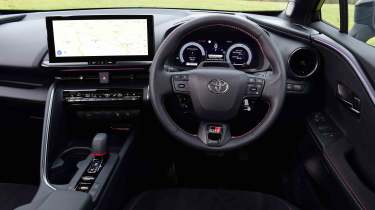
|
Pros |
|
| Cons |
|
Credit should be given to the designers at Toyota for not playing it safe and watering down the striking looks of the original C-HR. Instead, the latest C-HR looks even more arresting than before, with the GR Sport model coming standard in two-tone paint to really showcase its looks in the best light.
Other trim levels can be had with a contrasting roof colour for an additional cost. There’s one free Pure White colour, four metallic colours that can be optioned with a ‘Bi-Tone’ contrast roof, and two premium colours – although the latter costs around £1,000.
Interior and dashboard design
Inside, Toyota hasn’t deviated much from the stylised formula that made the first C-HR such a success. There’s a fully digital instrument panel, a whopping 12.3-inch infotainment system touchscreen in higher-spec models (lesser C-HRs make do with an eight-inch display), and wireless smartphone integration.
We prefer having actual, physical controls because they’re easier to use on the move compared with the purely touchscreen-based systems used in the DS 3 and Peugeot 2008, which can be very distracting because you have to look away from the road to find the right area of the screen to press.
Materials and build quality
Quality plastics and thick padding are featured in all key areas of the interior, while sensibly positioned toggle controls in the centre of the dash control the ventilation system and heated seats.
Toyota has a pretty robust reputation for quality, and the C-HR feels as well screwed together as we’d expect. A Toyota C-HR in Excel trim spent six months on our long-term test fleet, and we didn’t encounter any interior foibles during this time.
Infotainment, sat-nav and stereo
The entry-level Icon C-HR has a smaller 8.0-inch screen, while everything from Design trim and above gets the larger 12.3-inch screen we’ve tried in other Toyota cars, including the Toyota bZ4X.
The previous C-HR had an outdated-looking infotainment setup. The latest screen is much improved, not just in terms of layout but also in terms of the speed of its responses. However, it still can’t quite match the highly impressive infotainment system featured in the Hyundai Kona, which is faster still.
A wireless charging pad comes as standard on mid-range Design trim cars, as well as sat-nav. All versions come with Android Auto or Apple CarPlay if you want to bypass the built-in apps and infotainment system in favour of your phone.
All cars have a six-speaker sound system, which can be upgraded to a nine-speaker JBL system on Excel trim. The top-of-the-range GR Sport gets this stereo upgrade as standard.
“The C-HR is one of those cars you can just jump in and drive; little touches such as the wireless phone charging pad and a memory function for the driver’s seat position make for a quick getaway with the minimum of fuss, while the premium sports seats offer decent support and are comfortable.” - Paul Adam, executive editor, who drove the C-HR on an Auto Express long-term test.
Boot space & practicality
|
Pros |
|
| Cons |
|
The sleek roofline of the Toyota C-HR can fool you into thinking it’s a much smaller car than it actually is. In terms of length, it’s a little bit longer than a Hyundai Kona, and just shy of a SEAT Ateca. The C-HR is also taller than a Kia Niro, but doesn’t quite reach the ‘lofty’ heights of the Renault Captur.
Get inside, and you’d think that you were driving something more akin to an MPV. The windscreen's base seems to be in a different postcode from the driver, stretching beyond a very deep dashboard. The bonnet ahead of the windscreen slopes away, making gauging the car’s extremities difficult. That’s why we think opting for a mid-range Design will be worthwhile, as it will include front and rear parking sensors to assist you. There are large side door mirrors to assist when changing lanes on the motorway, and blind spot monitoring is standard to alert you to anything hiding in your blind spot.
| Dimensions | |
| Length | 4,362mm |
| Width | 1,832mm |
| Height | 1,564mm |
| Number of seats | 5 |
| Boot space | 388 litres (1.8 Hybrid) 364 litres (2.0 Hybrid) 310 litres (2.0 PHEV) |
Dimensions and size
At 4,362mm long, 1,832mm wide, and 1,564mm tall, the latest C-HR is longer than a Hyundai Kona, but slightly shorter than a Skoda Karoq.
Driving position, seats & space in the front
C-HR drivers get the slightly raised position that many SUV buyers seem to crave, and both front seat occupants have a decent amount of room to stretch out. The C-HR’s svelte design will impede headroom for the tallest passengers, but the majority of people will be able to get comfortable enough in the front of this small SUV.
Seats & space in the back
Space in the back is decent enough and compares well with what you’ll find in some small SUVs like the Jeep Avenger, Peugeot 2008 and Vauxhall Mokka. Two ISOFIX points are provided on the outer rear seating positions, although parents may rue having to put children in the back because the angle of the rear roof pillar means you’ll need to duck down in order to lean in.
The door opening isn’t the largest, making it difficult to install a child seat. If you need more practicality, consider the more conservatively styled Nissan Qashqai, with its nearly 90-degree rear door openings, or step up to something like the Toyota brand’s larger RAV4 SUV.

Boot space
The 1.8-litre C-HR’s 388-litre boot is much more generous than the 319-litre Honda HR-V, but trails the 466-litre Kona and 479-litre Qashqai. It doesn’t come with the latter’s clever dividing panels to prevent items from sliding deeper into the boot, and forcing you to lean in quite so much to unpack your shopping bags.
One word of caution, just like in the regular Toyota Corolla hatchback, choosing the 2.0 Hybrid means you’ll pay a practicality penalty. That’s because the 12-volt battery has to be placed in the boot, robbing you of 24 litres of capacity. Hardly a deal-breaker, but it’s something worth considering.
What’s more of a concern is the nearly 80 litres that are lost with the battery pack of the 2.0 plug-in hybrid, reducing overall capacity to 310 litres – much less than what you’ll find in similar PHEV versions of the Cupra Formentor and Kia Niro. Indeed, it’s even smaller than one of our favourite superminis, the Renault Clio.
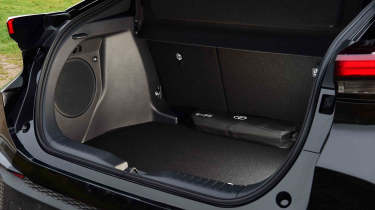
Towing
Something else worth considering if you’re interested in towing is that no version of C-HR can pull more than a 750kg braked trailer. If you need something more capable, a Kona Hybrid can lug up to 1,300kg, or you could go back to traditional petrol or diesel power and get something like the Skoda Karoq, which can pull up to 2,100kg.
“At a maximum of 388 litres, the C-HR’s boot is pretty small for a car in this class. The load lip is also very high, and the space is a little awkward, with pronounced intrusions poking out just ahead of the rear bench. Once those seats are folded, they leave a big step in the load area, too.” - Alex Ingram, chief reviewer.
Reliability & safety
|
Pros |
|
| Cons |
|
The latest C-HR gets the maximum five-star safety rating according to experts Euro NCAP, putting it ahead of the Hyundai Kona and Honda HR-V - both of which could only muster a four-star rating.
Every model gets autonomous emergency braking to help prevent or mitigate low-speed collisions with pedestrians and cyclists around town. At higher speeds, there’s adaptive cruise control to maintain a safe distance from the car ahead, and lane departure warning and lane-keeping assist to help keep you within your lane. Blind spot monitoring will warn you of other vehicles alongside you on the motorway.
jRoad sign recognition is also standard, and helps to warn you of speed limit changes to save you from getting a speeding fine. There’s also an emergency eCall system to alert the emergency services of your location should you get involved in a serious collision.
Further up the range, Design comes with a rear-cross traffic alert system to let you know if vehicles are crossing your path when reversing onto a road. Excel comes with a front-cross traffic alert, which does the same at the front. The latter is particularly helpful in the countryside when overgrown hedgerows obstruct your view at junctions.
The current C-HR is yet to appear in our Driver Power survey. As a brand, though, Toyota came in 12th out of 32 manufacturers in our most recent best manufacturer rankings, ahead of fellow hybrid SUV makers Honda and Nissan.
| Key standard safety features |
| Euro NCAP safety ratings |
|
Buying and owning
- Best buy: Toyota C-HR 1.8 Hybrid Icon
If you want extreme styling, appreciate long equipment lists, and need something highly efficient, the Toyota C-HR is a fine hybrid SUV choice. The fact that it drives well and can now be had with a plug-in hybrid option just makes the deal sweeter.
There are a number of trim levels and powertrains to choose from, but the majority of drivers will be served well enough by the base Icon model powered by the 1.8-litre full-hybrid. While this engine is the slowest of the bunch, it still holds up against motorway traffic. Official fuel economy of over 60mpg is not to be sniffed at, either.
Toyota C-HR alternatives
There’s no shortage of small SUVs on today’s market, so the Toyota C-HR rivals to choose from. For those who want a funky and distinctive Japanese model, this Toyota’s closest competitor is the highly popular Nissan Juke. For those who aren’t too bothered about standing out from the crowd, there are also more conservatively styled models including the Skoda Karoq, Volkswagen T-Cross and Renault Captur. If you’re after a blend of practicality and driving fun, the Ford Puma is the one of the very best cars to drive in this class.
Latest deals on the C-HR and rivals
Frequently Asked Questions
We think the Toyota C-HR is a fine, well-made, highly efficient, and good-to-drive hybrid small SUV. However, there are cheaper, and more practical options out there that are just as fuel efficient.
New & used Toyota C-HR deals
